A Brief History of the Grolier Club
ON THE EVENING OF JANUARY 23, 1884, New York printing press manufacturer and book collector Robert Hoe invited to his home eight fellow bibliophiles to discuss the formation of a club devoted to the book arts. Although the nine men differed in age, occupation and social position, they shared the opinion that the arts of printing and typography in late 19th-century America were in need of reform.
Hoe and his associates were all involved in the editing, design, production, sale or acquisition of fine books, and his invitation fired their imaginations. They were also men of action, and before the evening ended, a resolution had been adopted specifying the purpose of the organization, a committee had been appointed to choose a name for the group, and another to draft a constitution. Within two weeks, a suggestion that the fledgling organization call itself after the great French bibliophile Jean Grolier (1489/90-1565) had been passed by acclamation, a constitution duly drawn up, and "The Grolier Club of the City of New-York" was a going concern. (Below right: "Jean Grolier in the House of Aldus Manutius," 1894, by F. Flameng; collection of the Grolier Club.)
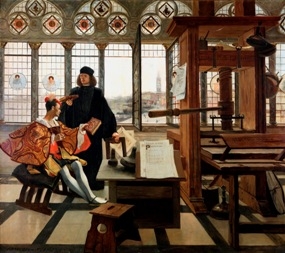
The object of the Grolier Club (to quote from its Constitution) is "to foster the study, collecting, and appreciation of books and works on paper, their art, history, production, and commerce. It shall pursue this mission through the maintenance of a library devoted to all aspects of the book and graphic arts and especially bibliography; through the occasional publication of books designed to illustrate, promote and encourage the book and graphic arts; through exhibitions and educational programs for its members and the general public; and through the maintenance of a Club building for the safekeeping of its property, and otherwise suitable for the purposes of the Club."
Breaking that description down into its constituent parts, the Grolier Club is, first of all, a fellowship of men and women devoted to books and the graphic arts. The Club currently numbers nearly 800 members, mostly American, but including a number of English, European, and Asian bibliophiles as well. Membership is by nomination, and recommendations for membership are made on the basis of a candidate's passion for books, as demonstrated by his or her outstanding activity as a collector, scholar, librarian, printer, or participation in some other bookish pursuit. (More details can be found here.)
Its founders intended the Grolier Club to lead by example in promoting the book arts, and in its Constitution explicitly provided for the "occasional publication of books" designed to further that purpose. In 1884 founding member Robert Hoe modestly referred to the Club's first publication effort (an edition of the 1637 Decree of Star Chamber Concerning Printing) as "a pretty nice specimen of printing," and the long list of Grolier Club publications—over 400 to date—contains a good many such: the 1889 edition of Richard de Bury's Philobiblon; Rudolph Ruzicka's 1915 New York, a hymn to the city in color wood-engravings; and Stanley Morison's stunning 1933 edition of Fra Luca de Pacioli (below), to name just a few.
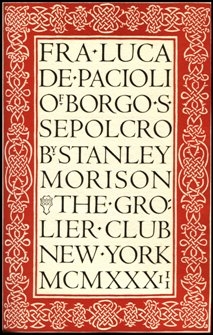
In 1995 a new series of Club-sponsored fine-printing was inaugurated with an edition of Keats' Letters From a Walking Tour, designed by Jerry Kelly and printed by Daniel Keleher on hand-made paper at the Wild Carrot Letterpress. The latest work in that series is For Jean Grolier & His Friends: 125 Years of Grolier Club Exhibitions & Publications 1884-2008, published in 2009. The Club is also proud of its bibliographical works, particularly the so-called "Grolier Hundred" catalogues, such as One Hundred Books Famous in Medicine, published in 1994, and A Century for the Century: Fine Printed Books 1900-1999, published in 1999.
The "Grolier Hundred" bibliographies were created as exhibition catalogues, and there is a very close relationship between the publication program of the Grolier Club and its century-old series of exhibitions. The Club sponsors nine of these a year, all open to the public free of charge, and recent themes have included early photographically illustrated books ("The Truthful Lens," 1980), "Bibliography, Its History and Development" (1984), "The American Livre de Peintre" (1993), outstanding private libraries ("The Book Room: Georgia O'Keeffe's Library in Abiquiu," 1998, modern fine presses ("K. K. Merker: Serving the Muse / Stone Wall Press and Windhover Press, 1956-96, 1997"), printing on vellum ("One Text, Two Results: Printing on Paper and Vellum," 1998), American color plate books ("Stamped With a National Character: Nineteenth-Century American Color Plate Books"), and Victorian publishers' bindings ("The Art of Publishers' Bookbindings, 1815-1915"). The Club's exhibition hall is the vital center of the organization, the place where its mission—the documentation, illustration, promotion and encouragement of the book arts—is communicated to the book-loving public.
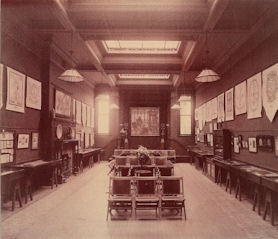
Another central focus is the Grolier Club Library. The theme of this 100,000-volume collection is books about books—author and subject bibliographies (including many rare and early examples), histories of printing, publishing and collecting, and exhibition catalogues—coupled with a modest-sized but quite fine teaching 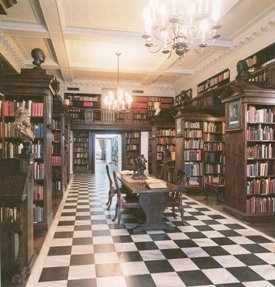 collection of examples, from illuminated manuscripts and leaves from the 42-Line Gutenberg Bible to modern private press books. But the research core of the Library, the material that draws scholars, is the 60,000-volume collection of bookseller and book auction catalogues. For over a hundred years the Club has solicited and made available to its members the current catalogues of every major European and American antiquarian book dealer and auction house. When these became outdated they were not discarded, as often happens, but carefully filed away. To this core collection have been added rare English and European catalogues from the 17th, 18th and early 19th centuries, the result being a uniquely valuable archive of the antiquarian book trade and of book collecting, one which is today widely used by researchers in all aspects of book history.
collection of examples, from illuminated manuscripts and leaves from the 42-Line Gutenberg Bible to modern private press books. But the research core of the Library, the material that draws scholars, is the 60,000-volume collection of bookseller and book auction catalogues. For over a hundred years the Club has solicited and made available to its members the current catalogues of every major European and American antiquarian book dealer and auction house. When these became outdated they were not discarded, as often happens, but carefully filed away. To this core collection have been added rare English and European catalogues from the 17th, 18th and early 19th centuries, the result being a uniquely valuable archive of the antiquarian book trade and of book collecting, one which is today widely used by researchers in all aspects of book history.
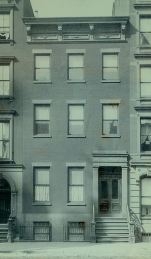
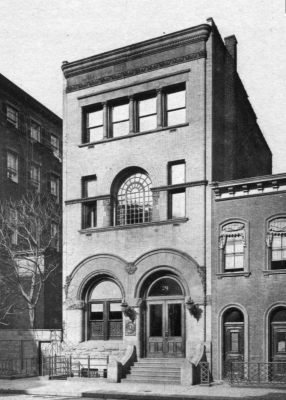
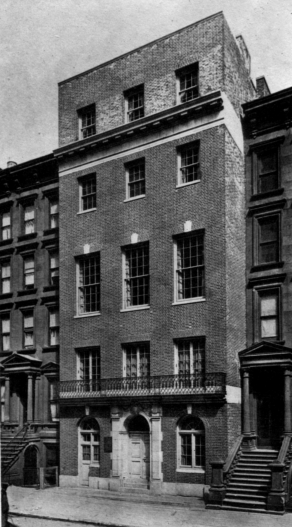
Growth of the Library collections, increased membership, and steady expansion of its public programs has forced the Grolier Club to seek larger quarters more than once in the last 125 years. The Club's first home (above left) was a few rented rooms at 64 Madison Avenue. These were inadequate almost from the start, and in 1890 the Club moved into a robust Romanesque Revival building (above center), purpose-built to house the fledgling society and its activities; this survives today at 29 East 32nd Street as a designated landmark. The present Clubhouse (above right) is a neo-Georgian town-house on East 60th Street in Midtown Manhattan. Designed for the Club in 1917 by member Bertram Grosvenor Goodhue, the six-story building holds—barely—a public exhibition/lecture hall, the Library, and several book-lined conference and meeting rooms. The newest of these is the Phillipps Room, renovated to house a spectacular collection (the gift of a member) of books, manuscripts and ephemera relating to Sir Thomas Phillipps, that greatest and most eccentric of English book collectors.
Visitors to the Club often comment on the air of peace and tranquility pervading these rooms, but it is actually quite a busy place, and more active now than at any period in its past. The Grolier has always been more than a private bibliophile society, but in recent years the Club has taken on the responsibilities of a cultural institution of national, even international stature. The Grolier Club sponsors an increasing number of book-related lectures these days, often in partnership with other bibliophilic organizations; its publications reach broader audiences; Grolier exhibitions regularly attract notice in the press, and are more heavily attended by the general public than in the past; and the Library has long outgrown its original function as a reference collection for Grolier Club members, and has now gained a solid reputation of its own in the scholarly community. The Club does not subscribe to the popular millennial notion that the advent of computer technology necessarily signals the end of l'histoire du livre; on the contrary, if the past two decades are any indication, the Grolier Club's second century of involvement in the book arts promises to be even more exciting and productive than its first.
For more information contact:
Eric Holzenberg, Director
[email protected]